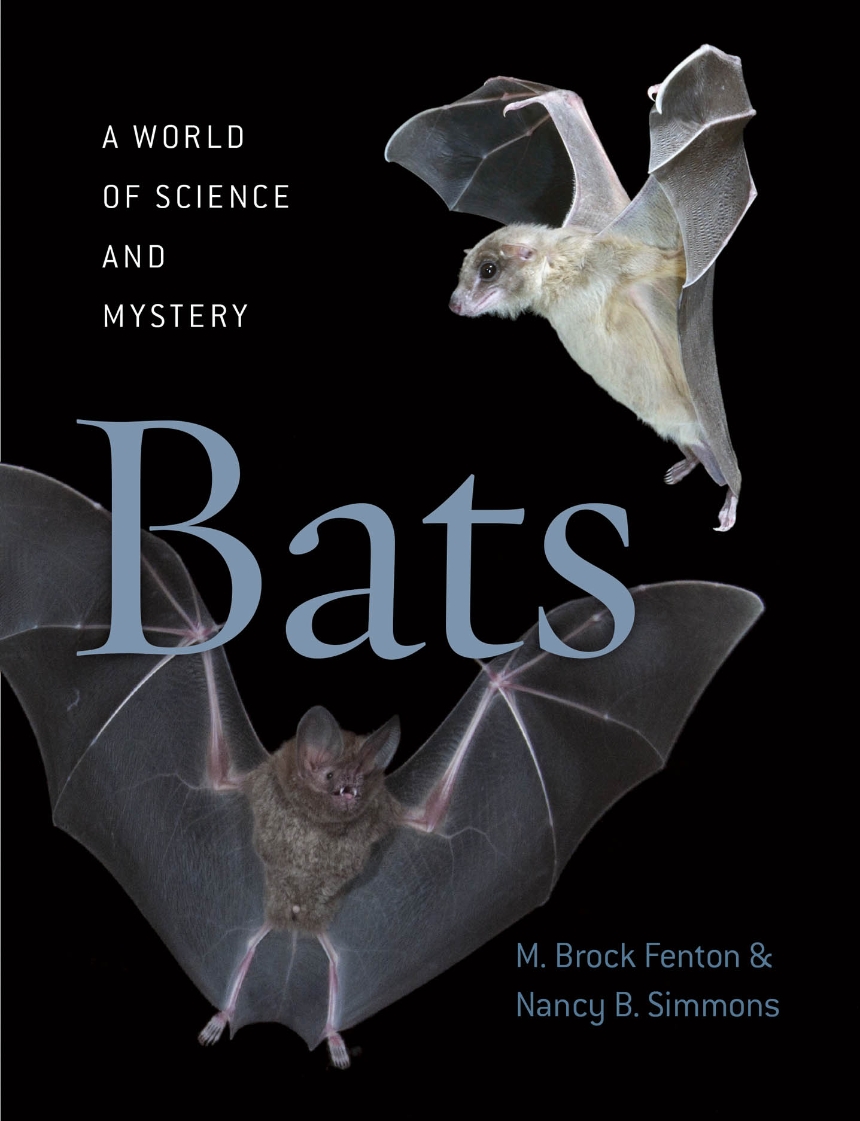Bats
A World of Science and Mystery
There are more than 1,300 species of bats—or almost a quarter of the world’s mammal species. But before you shrink in fear from these furry “creatures of the night,” consider the bat’s fundamental role in our ecosystem. A single brown bat can eat several thousand insects in a night. Bats also pollinate and disperse the seeds for many of the plants we love, from bananas to mangoes and figs.
Bats: A World of Science and Mystery presents these fascinating nocturnal creatures in a new light. Lush, full-color photographs portray bats in flight, feeding, and mating in views that show them in exceptional detail. The photos also take the reader into the roosts of bats, from caves and mines to the tents some bats build out of leaves. A comprehensive guide to what scientists know about the world of bats, the book begins with a look at bats’ origins and evolution. The book goes on to address a host of questions related to flight, diet, habitat, reproduction, and social structure: Why do some bats live alone and others in large colonies? When do bats reproduce and care for their young? How has the ability to fly—unique among mammals—influenced bats’ mating behavior? A chapter on biosonar, or echolocation, takes readers through the system of high-pitched calls bats emit to navigate and catch prey. More than half of the world’s bat species are either in decline or already considered endangered, and the book concludes with suggestions for what we can do to protect these species for future generations to benefit from and enjoy.
From the tiny “bumblebee bat”—the world’s smallest mammal—to the Giant Golden-Crowned Flying Fox, whose wingspan exceeds five feet, A Battery of Bats presents a panoramic view of one of the world’s most fascinating yet least-understood species.
Bats: A World of Science and Mystery presents these fascinating nocturnal creatures in a new light. Lush, full-color photographs portray bats in flight, feeding, and mating in views that show them in exceptional detail. The photos also take the reader into the roosts of bats, from caves and mines to the tents some bats build out of leaves. A comprehensive guide to what scientists know about the world of bats, the book begins with a look at bats’ origins and evolution. The book goes on to address a host of questions related to flight, diet, habitat, reproduction, and social structure: Why do some bats live alone and others in large colonies? When do bats reproduce and care for their young? How has the ability to fly—unique among mammals—influenced bats’ mating behavior? A chapter on biosonar, or echolocation, takes readers through the system of high-pitched calls bats emit to navigate and catch prey. More than half of the world’s bat species are either in decline or already considered endangered, and the book concludes with suggestions for what we can do to protect these species for future generations to benefit from and enjoy.
From the tiny “bumblebee bat”—the world’s smallest mammal—to the Giant Golden-Crowned Flying Fox, whose wingspan exceeds five feet, A Battery of Bats presents a panoramic view of one of the world’s most fascinating yet least-understood species.
See sample pages from the book (PDF format).
240 pages | 342 color plates, 29 line drawings | 8 1/2 x 11 | © 2015
Biological Sciences: Behavioral Biology, Conservation, Evolutionary Biology
Reviews
Table of Contents
Chapter 1: It’s a Bat!
Chapter 2: Ancient Bats
Chapter 3: Taking Off
Chapter 4: How Bats See with Sound
Chapter 5: What Bats Eat
Chapter 6: Where Bats Hang Out
Chapter 7: Life Histories of Bats
Chapter 8: Behavior of Bats
Chapter 9: Bats and Disease
Chapter 10: Bats and People
Chapter 11: Conservation of Bats
Chapter 12: What’s Next in Bats?
Annotated Bibliography
Acknowledgements
Index of Bat Names
Index
Chapter 2: Ancient Bats
Chapter 3: Taking Off
Chapter 4: How Bats See with Sound
Chapter 5: What Bats Eat
Chapter 6: Where Bats Hang Out
Chapter 7: Life Histories of Bats
Chapter 8: Behavior of Bats
Chapter 9: Bats and Disease
Chapter 10: Bats and People
Chapter 11: Conservation of Bats
Chapter 12: What’s Next in Bats?
Annotated Bibliography
Acknowledgements
Index of Bat Names
Index
